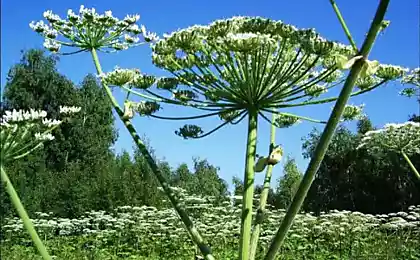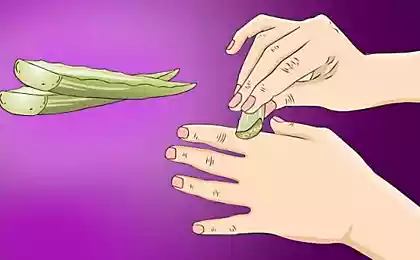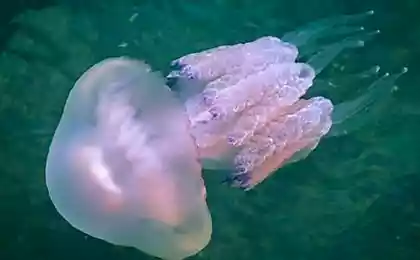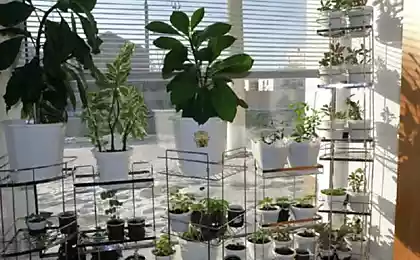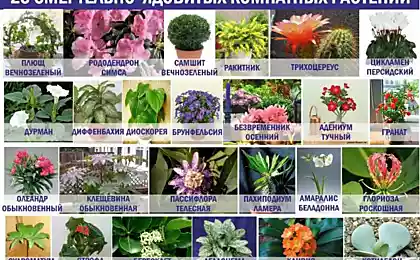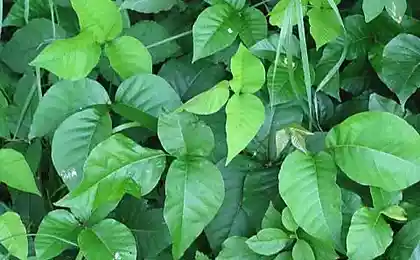642
You should know this! Burns from Hogweed Sosnowski
Burns from Hogweed Sosnowski — a terrible thing!
There are all known herbs, "communication" which should be avoided. Which of them can be hazardous to health, we were told the Director of the Institute of herbal medicine, doctor of medical Sciences, Professor Vladimir Korsun.
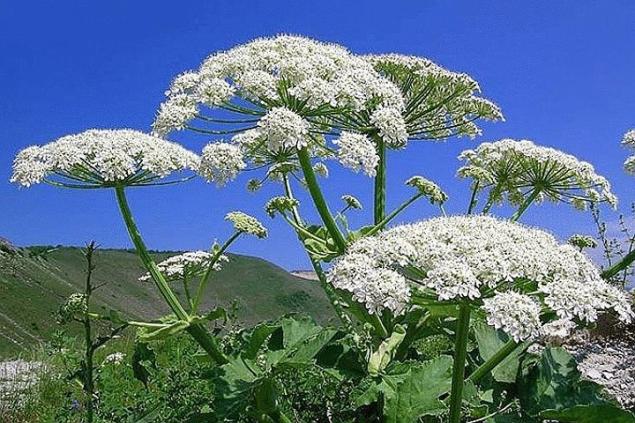
Do not stand under the Hogweed!
One of the most serious poisoners plants Hogweed Sosnowski. Unlike his harmless fellow Hogweed Siberian, this resident of the forests of the Moscow region is very, very dangerous.
What is dangerous
If the adult plant (maybe about three meters in height) to tear or to cut, its juice, when applied to the skin, causes serious burns, until the 1-St degree. The juice contains a substance that makes the skin very sensitive to UV light. Threat all parts of the plant – leaves, stems, fruit. Even a simple touch is enough to poisonous SAP gets on the skin and exposed to sunlight formed inflammation. Moreover, the juice can get to the skin even through clothing.
If the juice squirted profusely on the skin formed blisters filled with liquid. They heal for a very long time, leaving sores, and later spots and scars.
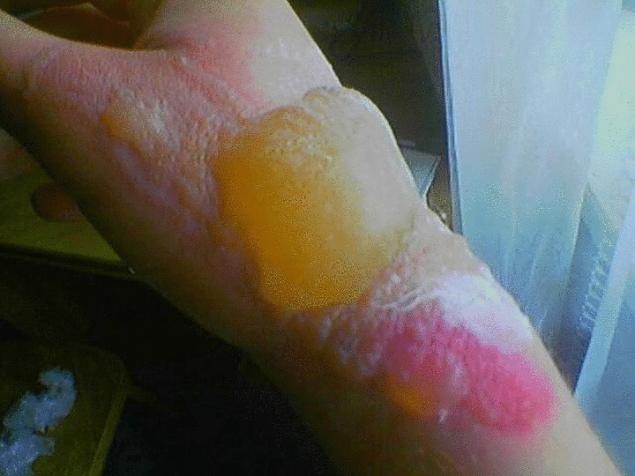
If the juice of Hogweed sprayed very liberally on the skin formed blisters filled with liquid. Photo: Facebook ISP
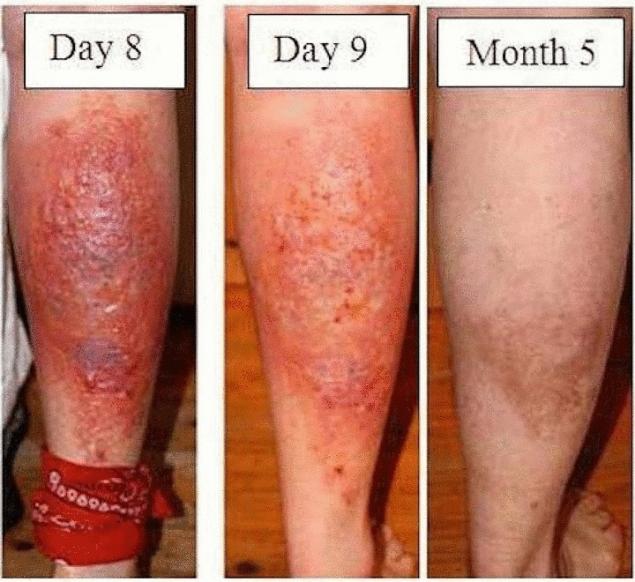
They heal for a very long time, leaving sores, and later spots and scars! Photo: Facebook ISP
What to do
Best of all, of course, do not touch this giant (by the way, at a young age the plant is safe, so cottages it is better to cut young). If the juice gets onto your body, immediately rinse it with water. If there is no water, then gently cover the place anything on the shade and run home. Don't let the sun to touch the damaged area.
Home wash thoroughly with running water. To relieve the itching, 2 — 3 days make lotions from strong black tea, oak bark, roots of Burnet. They will dry burn will remove the inflammation. Attention: burn Hogweed refers to the chemical, because of anti-agents such as panthenol-spray will not help.
The consequences
On the skin for a long time can stay dark spots or even scars if the burn was strong.
It is IMPORTANT
In cloudy weather when the sun is out, bacause it was safe. The furocoumarins it contains, act as photosensitizers: absorbing the sunlight, most of its energy transferred in a chemical reaction, which turns the burn. After recovery, the skin on the ground, burns for a long time darkens as photosensitizers stimulate the formation in the skin color pigment melanin.
Buttercup — not for bouquets
Buttercup burning — the plant is poisonous, despite the pretty yellow flowers.
What is dangerous
If the flower juice that got on the skin, causes an allergic reaction — irritation, blisters, similar to hives, and narichika.
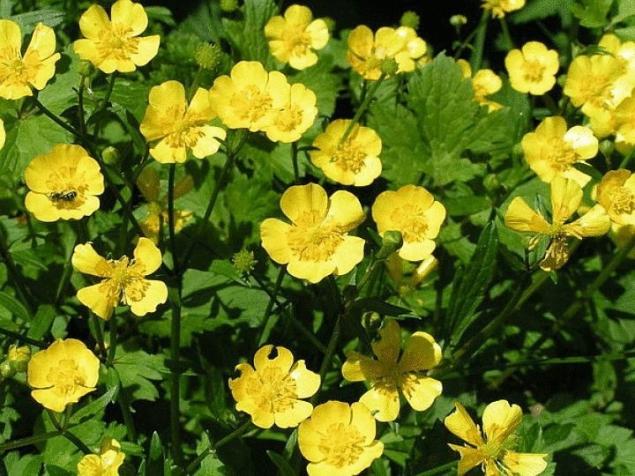
Buttercup burning — the plant is poisonous, despite the pretty yellow flowers.
What to do
Wash immediately with plenty of water. Then a shot of juice to wipe Apple cider vinegar — this will relieve itching and reduce the blisters. The propensity for skin allergies take an antihistamine, very damaged place, lubricate the anti-Allergy gel type fenistil.
The consequences
A few days can itch and itch.
Nettle — benefit or harm?
The usual and well-known nettle, growing wherever there is earth, too, cause unpleasant burns.
What is dangerous
Its leaves are covered with fine hairs — they burn. At the slightest touch of the head of hair breaks off and sharp edges pierce the skin, and the wound gets acrid juice. It contains histamine, causing inflammation of the tissues, choline, and formic acid.

Nettle leaves are covered with tiny hairs — they burn!
What to do
Flushing with water will not help here much because the juice gets under the skin and not nanee. Relieve itching will help ointment menovazin or a solution of Apple cider vinegar.
The consequences
Burn nettles is unpleasant, but not dangerous, and in something even useful — formic acid in small doses can relieve pain. Some even treat her rheumatism.
DANGEROUS BEAUTY BEDS
We do not even suspect that bright lush flowers in the country can be dangerous. Especially for kids who used to pull in my mouth all bright and unusual. To understand who is who among the residents of flower beds helps us to Deputy Director of the Institute of herbal medicine, the doctor-the phytotherapist Elena Korsun
Nightshade
Black nightshade (or, rather, dark blue) in its Mature state it is edible from its berries in the villages, even the pies were baked. But while he was immature, can cause poisoning. But the foliage of this plant is always poisonous.
Bittersweet nightshade (red berries) contains solanine, which is in green and in ripe berries. It is deadly poisonous substance. Also poisonous and highly ornamental nightshade (with large attractive bright red berries) — a Cuban cherry.
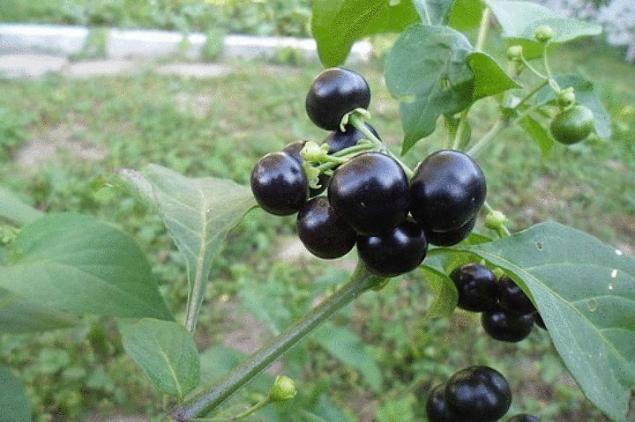
Black nightshade (or, rather, dark blue) in its Mature state it is edible from its berries in the villages even cakes were baked!
Delphinium
This is a favorite of many country undemanding plant. The most poisonous he had not considered the flowers and young shoots and seeds. As a rule, high harmful alkaloids the plant accumulates during growth and flowering.
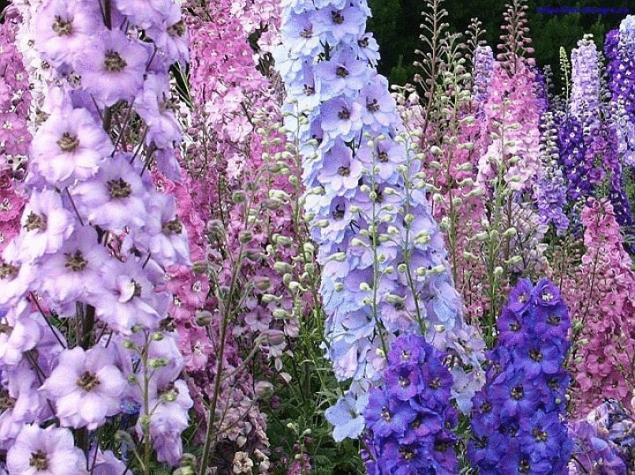
Delphinium — a favorite of many country undemanding plant.
Burning in the mouth, nausea, and slow heartbeat causes accidentally or specially swallowed a piece of the plant. Even if is long to smell you to feel symptoms similar to intoxication.
Castor
Bright showy plant like to plant near houses wipers Zhekov. Care it is almost not required, and pleasing to the eye to the cold weather.
Meanwhile, the fruits of the castor — fun "hedgehogs", and especially, their "outfit" — can be deadly poisonous. Contain substances ricin and ricinin (cyanides).

Castor-oil plant like to plant near houses wipers Zhekov.
Literally 2-3 seeds can fatally damage the liver and kidneys, to destroy the lung cells.
Lily of the valley
This humble plant can poison even the water in which you put a bunch. And all because its leaves contain a considerable dose of deadly convallatoxin. There is a dangerous substance and in colors, and lovely red berries that form after flowering. Even a small part of eaten plants can cause irregular heartbeat, headaches and even hallucinations.

Lily of the valley can poison even the water in which you put a bunch.
With Lily I advise you to work only with gloves. because even a drop of juice caught in an invisible wound, can cause poisoning.
Rhododendron
Lush blossoms of white, pink or purple flowers of this plant are poisonous, like all the rest of it.

The pollen of this plant causes tears and runny nose, even those who do not suffer from allergies.
If you chew the flower or leaf starts profuse drooling and watery eyes developing into vomiting, pressure drop, slow pulse and as the result of a coma...
Its pollen causes tears and runny nose, even those who do not suffer from allergies. And the toxins contained in the leaves, stems and flowers can cause convulsions, asphyxiation, and kidney failure.
No less poisonous, and a relative of the rhododendron — the mountain Laurel (kalmia latifolia). Its pollen can cause tears even e those people who had not suffered from allergies. And the toxins in the flowers and leaves, can cause choking and cramps.
By the WAY
Another great poisoners
— Hydrangea, blooming from summer to autumn, the lush blue flowers. Do not try to chew on them! However, as the leaves. All poisonous plants.
— Daffodils (their season is already over, but forewarned is forearmed). Even the smell of daffodils has a toxic effect: if you stay with a bouquet of these delicate flowers indoors, it starts to hurt the head. "To the tooth" especially poisonous serdtsevini flower.
— Digitalis, mixed colors jingle bells which adorn the flowerbeds. Upper leaves contain high concentrations of hazardous substances — digitonin. Toxic to humans and Pets.
— Oleander — beautiful lush shrub with fragrant small flowers. All poisonous. Even one leaf can cause a young child severe poisoning, problems with cardiac and neural activity.
— Elder red and herbal (not black) their leaves and roots, and especially the berries are highly poisonous. Contain the harmful substance amygdalin.
— Honeysuckle forest or plain. Often planted as an ornamental plant. Still bears the name "Wolfberry". Her beautiful red berries ripen in July-August. Inedible, it is highly poisonous.published
P. S. And remember, only by changing their consumption — together we change the world! ©
Source: m.kp.ru/daily/26391/3269191/
There are all known herbs, "communication" which should be avoided. Which of them can be hazardous to health, we were told the Director of the Institute of herbal medicine, doctor of medical Sciences, Professor Vladimir Korsun.

Do not stand under the Hogweed!
One of the most serious poisoners plants Hogweed Sosnowski. Unlike his harmless fellow Hogweed Siberian, this resident of the forests of the Moscow region is very, very dangerous.
What is dangerous
If the adult plant (maybe about three meters in height) to tear or to cut, its juice, when applied to the skin, causes serious burns, until the 1-St degree. The juice contains a substance that makes the skin very sensitive to UV light. Threat all parts of the plant – leaves, stems, fruit. Even a simple touch is enough to poisonous SAP gets on the skin and exposed to sunlight formed inflammation. Moreover, the juice can get to the skin even through clothing.
If the juice squirted profusely on the skin formed blisters filled with liquid. They heal for a very long time, leaving sores, and later spots and scars.

If the juice of Hogweed sprayed very liberally on the skin formed blisters filled with liquid. Photo: Facebook ISP

They heal for a very long time, leaving sores, and later spots and scars! Photo: Facebook ISP
What to do
Best of all, of course, do not touch this giant (by the way, at a young age the plant is safe, so cottages it is better to cut young). If the juice gets onto your body, immediately rinse it with water. If there is no water, then gently cover the place anything on the shade and run home. Don't let the sun to touch the damaged area.
Home wash thoroughly with running water. To relieve the itching, 2 — 3 days make lotions from strong black tea, oak bark, roots of Burnet. They will dry burn will remove the inflammation. Attention: burn Hogweed refers to the chemical, because of anti-agents such as panthenol-spray will not help.
The consequences
On the skin for a long time can stay dark spots or even scars if the burn was strong.
It is IMPORTANT
In cloudy weather when the sun is out, bacause it was safe. The furocoumarins it contains, act as photosensitizers: absorbing the sunlight, most of its energy transferred in a chemical reaction, which turns the burn. After recovery, the skin on the ground, burns for a long time darkens as photosensitizers stimulate the formation in the skin color pigment melanin.
Buttercup — not for bouquets
Buttercup burning — the plant is poisonous, despite the pretty yellow flowers.
What is dangerous
If the flower juice that got on the skin, causes an allergic reaction — irritation, blisters, similar to hives, and narichika.

Buttercup burning — the plant is poisonous, despite the pretty yellow flowers.
What to do
Wash immediately with plenty of water. Then a shot of juice to wipe Apple cider vinegar — this will relieve itching and reduce the blisters. The propensity for skin allergies take an antihistamine, very damaged place, lubricate the anti-Allergy gel type fenistil.
The consequences
A few days can itch and itch.
Nettle — benefit or harm?
The usual and well-known nettle, growing wherever there is earth, too, cause unpleasant burns.
What is dangerous
Its leaves are covered with fine hairs — they burn. At the slightest touch of the head of hair breaks off and sharp edges pierce the skin, and the wound gets acrid juice. It contains histamine, causing inflammation of the tissues, choline, and formic acid.

Nettle leaves are covered with tiny hairs — they burn!
What to do
Flushing with water will not help here much because the juice gets under the skin and not nanee. Relieve itching will help ointment menovazin or a solution of Apple cider vinegar.
The consequences
Burn nettles is unpleasant, but not dangerous, and in something even useful — formic acid in small doses can relieve pain. Some even treat her rheumatism.
DANGEROUS BEAUTY BEDS
We do not even suspect that bright lush flowers in the country can be dangerous. Especially for kids who used to pull in my mouth all bright and unusual. To understand who is who among the residents of flower beds helps us to Deputy Director of the Institute of herbal medicine, the doctor-the phytotherapist Elena Korsun
Nightshade
Black nightshade (or, rather, dark blue) in its Mature state it is edible from its berries in the villages, even the pies were baked. But while he was immature, can cause poisoning. But the foliage of this plant is always poisonous.
Bittersweet nightshade (red berries) contains solanine, which is in green and in ripe berries. It is deadly poisonous substance. Also poisonous and highly ornamental nightshade (with large attractive bright red berries) — a Cuban cherry.

Black nightshade (or, rather, dark blue) in its Mature state it is edible from its berries in the villages even cakes were baked!
Delphinium
This is a favorite of many country undemanding plant. The most poisonous he had not considered the flowers and young shoots and seeds. As a rule, high harmful alkaloids the plant accumulates during growth and flowering.

Delphinium — a favorite of many country undemanding plant.
Burning in the mouth, nausea, and slow heartbeat causes accidentally or specially swallowed a piece of the plant. Even if is long to smell you to feel symptoms similar to intoxication.
Castor
Bright showy plant like to plant near houses wipers Zhekov. Care it is almost not required, and pleasing to the eye to the cold weather.
Meanwhile, the fruits of the castor — fun "hedgehogs", and especially, their "outfit" — can be deadly poisonous. Contain substances ricin and ricinin (cyanides).

Castor-oil plant like to plant near houses wipers Zhekov.
Literally 2-3 seeds can fatally damage the liver and kidneys, to destroy the lung cells.
Lily of the valley
This humble plant can poison even the water in which you put a bunch. And all because its leaves contain a considerable dose of deadly convallatoxin. There is a dangerous substance and in colors, and lovely red berries that form after flowering. Even a small part of eaten plants can cause irregular heartbeat, headaches and even hallucinations.

Lily of the valley can poison even the water in which you put a bunch.
With Lily I advise you to work only with gloves. because even a drop of juice caught in an invisible wound, can cause poisoning.
Rhododendron
Lush blossoms of white, pink or purple flowers of this plant are poisonous, like all the rest of it.

The pollen of this plant causes tears and runny nose, even those who do not suffer from allergies.
If you chew the flower or leaf starts profuse drooling and watery eyes developing into vomiting, pressure drop, slow pulse and as the result of a coma...
Its pollen causes tears and runny nose, even those who do not suffer from allergies. And the toxins contained in the leaves, stems and flowers can cause convulsions, asphyxiation, and kidney failure.
No less poisonous, and a relative of the rhododendron — the mountain Laurel (kalmia latifolia). Its pollen can cause tears even e those people who had not suffered from allergies. And the toxins in the flowers and leaves, can cause choking and cramps.
By the WAY
Another great poisoners
— Hydrangea, blooming from summer to autumn, the lush blue flowers. Do not try to chew on them! However, as the leaves. All poisonous plants.
— Daffodils (their season is already over, but forewarned is forearmed). Even the smell of daffodils has a toxic effect: if you stay with a bouquet of these delicate flowers indoors, it starts to hurt the head. "To the tooth" especially poisonous serdtsevini flower.
— Digitalis, mixed colors jingle bells which adorn the flowerbeds. Upper leaves contain high concentrations of hazardous substances — digitonin. Toxic to humans and Pets.
— Oleander — beautiful lush shrub with fragrant small flowers. All poisonous. Even one leaf can cause a young child severe poisoning, problems with cardiac and neural activity.
— Elder red and herbal (not black) their leaves and roots, and especially the berries are highly poisonous. Contain the harmful substance amygdalin.
— Honeysuckle forest or plain. Often planted as an ornamental plant. Still bears the name "Wolfberry". Her beautiful red berries ripen in July-August. Inedible, it is highly poisonous.published
P. S. And remember, only by changing their consumption — together we change the world! ©
Source: m.kp.ru/daily/26391/3269191/

